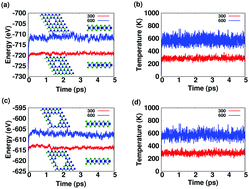Metal dichalcogenide nanomeshes: structural, electronic and magnetic properties†
Abstract
Motivated by the successful preparation of two-dimensional transition metal dichalcogenide (2D-TMD) nanomeshes in the last three years, we use density functional theory (DFT) to study the structural stability, mechanical, magnetic, and electronic properties of porous 2H-MoX2 (X = S, Se and Te) without and with pore passivation. We consider structures with multiple, systematically created pores. The molecular dynamics simulations and cohesive energy calculations showed the stability of the 2D-TMD nanomeshes, with larger stability for those with smaller pores. The lattice undergoes some deformations to accommodate the pore energetically, and as the pore size increases Young's modulus decreases. In most cases, the missing metal atoms disrupt the spin states’ even population, resulting in some nanomeshes becoming magnetic. The electronic gaps of the MoX2 nanomesh systems are diminished because of the emergence of pore-edge localized mid-gap metal 4d states in the spin-polarized spectrum, making some systems half-metallic. The oxygen passivation of the pore edges of 2D-TMD nanomeshes restores the even population of spin states, and makes those systems metallic. Our results can be used in different applications such as spintronics, ion chelation, and molecular sensing applications.



 Please wait while we load your content...
Please wait while we load your content...